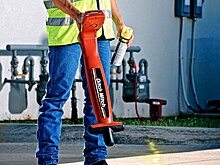Cable locator
This article needs additional citations for verification. (December 2016) |
A cable locator or cable avoidance tool (CAT) is an instrument used for detecting the presence and approximate location of buried services in advance of undertaking excavation works. It aims to avoid accidents while excavating.[1] A number of types of detecting technology can be employed by such instruments, including use of magnetic fields, radio frequencies, , metal detectors, ground-penetrating radar and RFID.[2]


Description[]
Underground cables are one of the things that enable telecommunication and power transmission. They are especially beneficial to densely populated areas, particularly those locations where overhead cable posts are unavailable or are not ideal.[3]
Locating underground cables—as well as other underground facilities—is an integral pre-excavation process mandated by laws and guided by a number of industry standards.[4] During excavations, underground cables become at risk of getting damaged. In fact, utility strikes are a common occurrence on construction sites, resulting in compromised worker and public safety, repair costs, and work delay, among others.[5]
Based on the 2018 Damage Information Reporting Tool (DIRT) Report of the Common Ground Alliance (CGA), some of the most common root causes of utility strikes include failure to call 811 before digging, improper excavation practices, and inaccurate marking of underground facilities.[6]
Furthermore, the CGA also noted that locator errors are one of the common causes of strike incidents. This emphasizes the need for understanding how cable locators work as well as how different cable types can be most accurately detected.
Detection Methods[]
Different cable locators employ different methods to function. The two known methods, made possible through naturally present (active) or naturally produced signals (passive) via a transmitter[7], are called the Active Utility Detection and Passive Utility Detection.
It’s important to note, however, that while both methods can help locators distinguish an underground utility, they do not confirm its presence nor its absolute location. Furthermore, an unmarked ground is not a guarantee that there are no utilities underground.[8]
References[]
- ^ Plastic Materials: Properties and Applications. Springer Science & Business Media. 2012. ISBN 9789401176149. Retrieved 16 February 2017.
- ^ Avoiding danger from underground services, HSG47 (third ed.). Health and Safety Executive. 2014. pp. 20–21. ISBN 978-0-7176-6584-6. Retrieved Nov 23, 2016.
- ^ Annestrand, S. (2003). "Encyclopedia of Physical Science and Technology". ScienceDirect. Retrieved 11 September 2020.
{{cite web}}: CS1 maint: url-status (link) - ^ Occupational Safety and Health Administration (2015). "Trenching and Excavation Safety" (PDF). OSHA. Retrieved 11 September 2020.
{{cite web}}: CS1 maint: url-status (link) - ^ Al-Bayati, A.; Panzer, L. (2019). "Reducing Damage to Underground Utilities: Lessons Learned from Damage Data and Excavators in North Carolina". Journal of Construction Engineering and Management. 145 (12): 12. doi:10.1061/(ASCE)CO.1943-7862.0001724 – via ResearchGate.
- ^ Common Ground Alliance (2019). "DIRT Annual Report for 2018" (PDF). Common Ground Alliance. Retrieved 11 September 2020.
{{cite web}}: CS1 maint: url-status (link) - ^ Salazar, D. (2020). "Underground Locators: Everything You Need to Know". Engineer Warehouse Learning Center. Retrieved 11 September 2020.
{{cite web}}: CS1 maint: url-status (link) - ^ TRANSPORTATION RESEARCH BOARD (2009). "Encouraging Innovation in Locating and Characterizing Underground Utilities". The National Academies of Sciences, Engineering, Medicine. Retrieved 11 September 2020.
{{cite web}}: CS1 maint: url-status (link)
- Civil engineering stubs
- Civil engineering